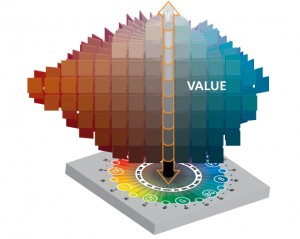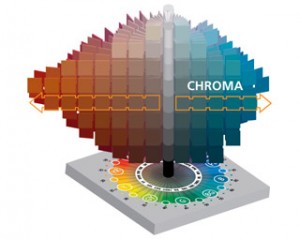I was interested to find out about what this was as it plays such a vital part in the processes of colour being correct. Julian also metioned that any one applying for a job at Graham & Brown will need to take a colour test. This will determin whether they are considered a successful or unsuccessful candidate for the job. So this just shows how important it is to Graham & Brown to employ staff that have an eye for colour.
The Munsell Colour Theory is a legacy created by Albert H. Munsell in the first decade of the 20th century. His intentions were to help people communicate colour easily and accurately. It provides reliability, flexibility and logical simplicity to visual colour matching and colour identification.The Munsell system organizes color the way the human eye see colour, making it easy to identify the colors you want. It also serves as the basis for the way color is manufactured, making it accurate and reliable for visually matching color.
The Munsell color order system is based on a three-dimensional model depicted in the Munsell color tree. Each color has three qualities or attributes:
- Hue – color such as red, orange, yellow, etc.
- Value – the lightness or darkness of a color
- Chroma – the saturation or brilliance of a color
Value indicates the lightness of a color. The scale of value ranges from 0 for pure black to 10 for pure white. Black, white and the grays between them are called “neutral colors”. They have no hue. Colors that have a hue are called “chromatic colors.”
Chroma is the departure degree of a color from the neutral color of the same value. Colors of low chroma are sometimes called “weak,” while those of high chroma are said to be “highly saturated,” “strong,” or “vivid.”





No comments:
Post a Comment